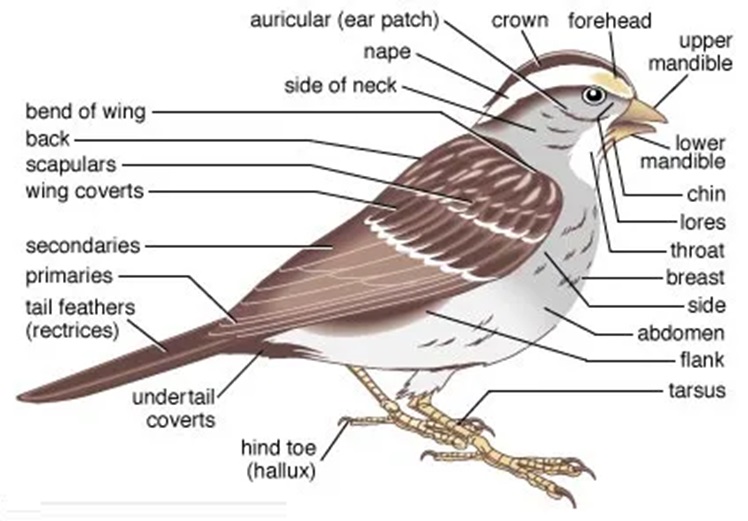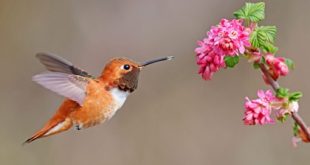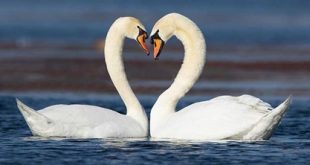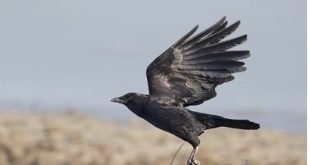Bulbuls are fascinating small- to medium-sized passerine birds belonging to the family Pycnonotidae. They are widely distributed across Asia, Africa, and the Middle East, with their distinctive calls, colorful plumage, and energetic behavior making them a joy to observe in the wild or in urban gardens. Like all birds, the body structure of a bulbul is specially adapted for survival, allowing it to thrive in its natural environment. This article explores the various body parts of a bulbul and their respective functions.
A Body Parts Of Bulbul

1. Head
The head of a bulbul houses several critical organs that contribute to its survival and behavior.
- Beak (Bill): The bulbul’s beak is small and slightly curved, suited for a variety of tasks. It is used to pluck fruits, catch insects, and gather nesting material. The beak also assists in preening, a vital behavior for maintaining feather health.
- Eyes: Positioned on either side of the head, the bulbul’s eyes provide a wide field of vision. This binocular vision is essential for spotting predators, finding food, and navigating its surroundings. Bulbuls have excellent color vision, aiding in identifying ripe fruits and recognizing mates.
- Nostrils: Located at the base of the beak, the nostrils enable the bird to breathe efficiently. Their placement ensures they are protected from debris and dust during feeding and flight.
- Ears: Though not externally visible, the bulbul’s ears are situated just behind the eyes. They are essential for detecting calls from other bulbuls and recognizing threats in their environment.
- Crest (if present): Some bulbul species, like the red-whiskered bulbul, have a prominent crest on their heads. This feature is used in communication and displays of dominance or courtship.
2. Neck
The neck of a bulbul is short but highly flexible, allowing it to move its head in all directions. This flexibility is vital for preening feathers, feeding, and scanning for predators.
3. Body
The bulbul’s body is streamlined to facilitate efficient flight and agile movements.
- Feathers: The plumage of a bulbul varies depending on the species. Feathers provide insulation, protect the skin from injury, and enable flight. Brightly colored feathers may play a role in attracting mates, while duller plumage offers camouflage from predators.
- Wings: The wings of a bulbul are well-developed and adapted for short bursts of flight. These wings are crucial for escaping predators, foraging across large areas, and migrating in some species. The flight feathers on the wings—primary, secondary, and tertiary feathers—work together to generate lift and thrust.
- Breast Muscles: Located under the feathers, the breast muscles (pectorals) are powerful and responsible for the flapping motion of the wings during flight.
4. Tail
The tail of a bulbul serves several purposes:
- Steering: During flight, the tail acts as a rudder, helping the bird to change direction and maintain balance.
- Communication: Some species use tail movements to communicate with other birds, signaling alarm or courtship.
- Display: The tail feathers can be fanned out during displays to attract mates or deter rivals.
5. Legs and Feet
Bulbuls have slender legs and feet adapted for perching and hopping.
- Perching: Their feet have three forward-facing toes and one backward-facing toe (anisodactyl arrangement), enabling a firm grip on branches.
- Mobility: While not designed for running, the legs allow the bird to hop between branches and forage on the ground.
- Claws: The sharp claws help bulbuls cling to tree bark or other surfaces.
6. Internal Organs
The internal anatomy of a bulbul is designed for efficient metabolism and survival.
- Heart: A bulbul’s heart beats rapidly, supporting its high metabolic rate. This is crucial for sustained activity like flying and foraging.
- Lungs and Air Sacs: Birds, including bulbuls, have a unique respiratory system with lungs and air sacs that ensure a continuous supply of oxygen during flight.
- Digestive System: The digestive system includes the crop, gizzard, and intestines, specialized for processing fruits, seeds, and insects. The gizzard grinds food with the help of ingested grit, while the crop temporarily stores food.
- Reproductive Organs: During the breeding season, the reproductive organs of a bulbul enlarge to facilitate reproduction. Females lay eggs in nests built with precision, often in shrubs or trees.
7. Vocal Apparatus (Syrinx)
Bulbuls are known for their melodious songs and calls. These sounds are produced by the syrinx, a specialized vocal organ located at the base of the trachea. Each species has its unique repertoire of calls, used for communication, mate attraction, and territorial defense.
8. Skin and Oil Gland
The bulbul’s skin is thin and covered by feathers. Beneath the feathers lies the uropygial gland (preen gland) at the base of the tail. This gland secretes oil that the bird spreads over its feathers during preening, ensuring they remain waterproof and flexible.
9. Brain and Nervous System
The brain of a bulbul is relatively small but highly efficient. It coordinates complex behaviors such as flight, song production, and problem-solving. The nervous system processes sensory input from the eyes, ears, and other organs, enabling the bird to respond quickly to its environment.
Adaptations for Survival
Each part of the bulbul’s body is uniquely adapted to its lifestyle:
- Flight Efficiency: Lightweight bones, strong muscles, and aerodynamic feathers allow for agile and energy-efficient flight.
- Foraging Abilities: The beak and claws are well-suited for extracting food from various sources, while sharp eyesight aids in locating it.
- Social Interactions: Bright plumage, distinctive calls, and body language facilitate communication and mate selection.
Conclusion
The bulbul is a marvel of natural adaptation, with each body part playing a crucial role in its survival and daily activities. From the precision of its beak to the agility of its wings, the bulbul demonstrates the intricate balance of form and function that defines bird life. Understanding these features not only deepens our appreciation for these lively birds but also highlights the importance of conserving their habitats to ensure their continued presence in our ecosystems.


